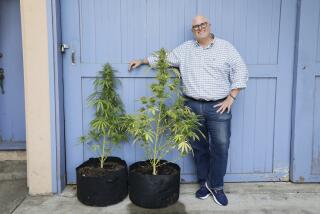Small Space, Sunlight = Recipe for 9 Herbs
- Share via
A space of 35 square feet is all that is needed to grow nine of the most commonly used herbs--basil, chives, parsley, sage, oregano, mint, thyme, dill and rosemary.
The plants generally require little care once they are established--merely cutting off selected stems for cooking use is sufficient to keep them healthy and attractive.
The best spot for herbs is one that gets at least six hours of full sunlight each day, is sheltered from strong winds and has moderately good soil.
The primary requirement for the soil is good drainage. If your soil has a high clay content, add sand to help promote drainage. Herbs generally do not require extremely rich soil, but a moderate amount of organic matter dug into the soil will supply all required nutrients.
The beginning gardener will find it easier to purchase seedlings rather than start from seed.
Look for healthy plant stock--strong plants have rich, green foliage with no yellowing leaves. As a rule, it is better to use plants that have been successfully transplanted into pots, rather than plants in starter flats.
Before planting, test the soil for proper drainage by spraying the bed with water. If the water pools and does not appear to drain well, add sand and compost, then turn the soil over, loosening the soil to a depth of 10 to 12 inches. Rake out the garden bed, removing rocks or roots that come to the surface.
Space the plants with the mature size of each in mind. Planting too close will inhibit their growth and leave them competing for moisture, sunlight and nutrients.
With some herbs, it is useful to sink a large pot into the garden and plant the herbs in the pot. Rosemary, for example, is a tender perennial that needs to come inside during harsh winter months. To reduce transplant shock, you can dig up the pot and bring it inside.
Mint also works well with this treatment. Members of the mint family are rather aggressive and will spread underground, taking over a garden if not controlled. By planting the herb in a sunken pot, the roots are limited and will not spread.
Once the plants are well established, you can begin to use leaves for cooking.
At the end of the growing season, annual plants can be pulled up by their roots and hung upside down to dry. Perennial herbs can be cut back almost to the ground, their leaves dried in the same manner.






